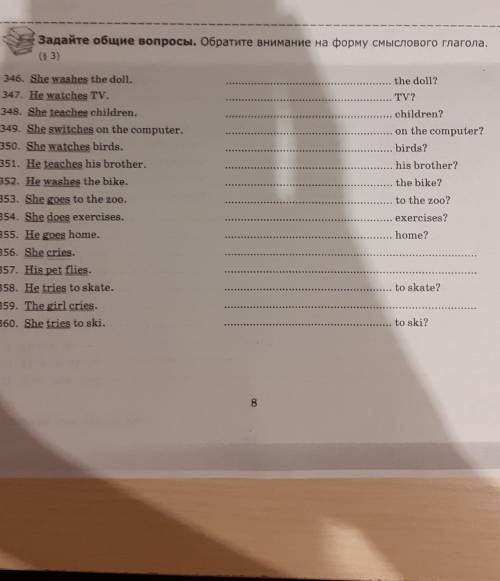Задайте общие вопросы. Обратите внимание на форму смыслового глагола. (63)
У спубленное изучение
346. She washes the doll.
347. He watches TV.
348. She teaches children.
349. She switches on the computer.
350. She watches birds.
351. He teaches his brother.
352. He washes the bike.
353. She goes to the zoo.
354. She does exercises.
355. He goes home.
356. She cries.
357. His pet flies.
358. He tries to skate.
359. The girl cries.
360. She tries to ski.
the doll?
TV?
children?
on the computer?
birds?
his brother?
the bike?
to the zoo?
exercises?
home?
to skate?
to ski?

Другие вопросы по теме Английский язык
Популярные вопросы
- Выпишите все термины которые здесь находятся! Надеюсь на фото все понято.За...
1 - Проанализируйте: р*(к-х-1)-с*(к-х-1)=...
1 - Задача 8.1. Заполните экран синим цветом. Введите строку с клавиатуры и...
2 - Написати лист до письменника сент - Екзупері...
1 - Приведите примеры криминогенных мест во время досугового момента....
3 - найти три орфографические ошибки...
2 - Яку роль виконує ендокринна система в розвитку стресорних реакцій? 8. Яке...
3 - ответ скинте мне в СМС НУЖНО ЗДАТЬ....
3 - Сделайте конспект по географии по теме Природные комплексы как части географической...
3 - 3х + 2х^2– 5 = 0 х^2+ 2 + 3х = 0 х2+ 4х + 4 = 0 3х^2 + 8х = 3 6а^2+ 2 =...
2
Let's start with the first sentence: "She washes the doll." To form a general question, we need to switch the positions of the subject ("She") and the verb ("washes"). So the general question would be: "Does she wash the doll?"
Moving on to the next sentence: "He watches TV." We apply the same rule and form the general question: "Does he watch TV?"
Now let's apply the same process for the remaining sentences:
"She teaches children." - "Does she teach children?"
"She switches on the computer." - "Does she switch on the computer?"
"She watches birds." - "Does she watch birds?"
"He teaches his brother." - "Does he teach his brother?"
"He washes the bike." - "Does he wash the bike?"
"She goes to the zoo." - "Does she go to the zoo?"
"She does exercises." - "Does she do exercises?"
"He goes home." - "Does he go home?"
"She cries." - "Does she cry?"
"His pet flies." - "Does his pet fly?"
"He tries to skate." - "Does he try to skate?"
"The girl cries." - "Does the girl cry?"
"She tries to ski." - "Does she try to ski?"
By forming these general questions, we can better understand the actions being described and gather more information about the subjects involved.